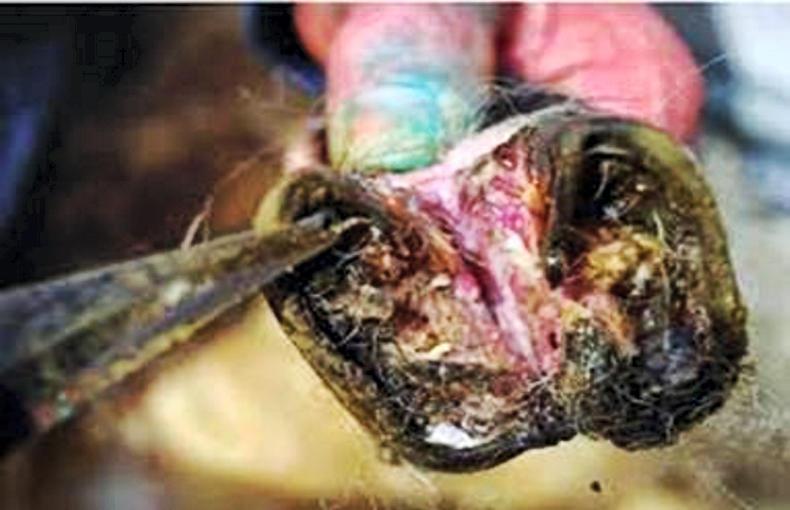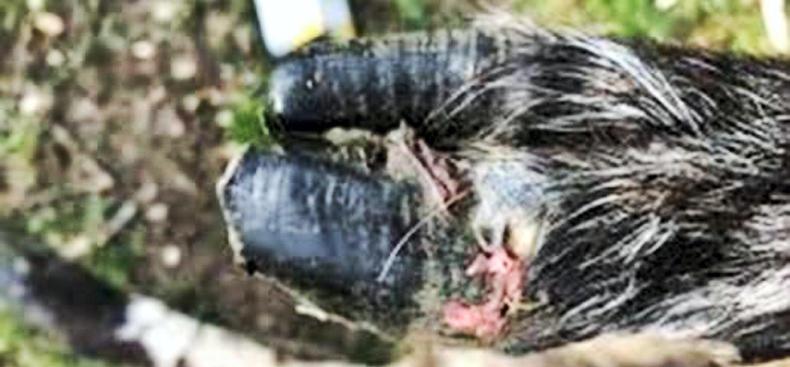Tuesday’s Farm Profit Programme open meeting in Caithness covered a wide range of topics from Stuart Ashworth discussing the current situation and potential opportunities in the red meat marketplace to Robert Gilchrist leading a discussion on winter housing protocols and diets.
Towards the end of the evening, Declan Marren led a discussion with vet Tom Southhall from DS McGregor Vets in Thurso on sheep lameness.
It is estimated that lameness costs the Scottish sheep industry something in the region of £26m per year, with around 10% of the average flock expected to be lame at any one time. The £26m is made up of not only the seen costs of dealing with lameness but also the unseen costs of performance loss in ewes and lambs.

Footrot between a sheeps toes.
Lameness in lambs can see them lose over 50g of weight per day. On a lamb in later season that might be doing upwards of 200g per day of weight gain otherwise, this is a loss of 25%. It can also make the lamb more prone to other diseases such as Pasteurella and ewes more prone to abortion or twin lamb disease due to reduced feed intake.
It can also lead to fertility issues with tups. Not only that, a tup with sore feet is less inclined to move around the field serving ewes, further compounding the issue.
Lameness can also drive issues with the public perception of farming as it is a very noticeable condition when looking over the fence.

Declan Marran, FPP advisor, speaking at the event in Caithness.
It is also estimated that two-thirds of all antibiotic use in the sheep flock in the UK is to treat lameness. This is not only a significant cost financially to the industry, it is also a further cost through the public perception of antibiotic use in the production of red meat. Reducing antibiotic use is a key government target for the red meat sector, thus reducing lameness has the long-term potential to satisfy this aim.
What are the main causes of lameness?
Table 1 shows the incidence of each cause, with scald heading the table at 40% and footrot coming in at 20%, with a confounding factor between the two being that scald can lead to footrot as they are both caused by the same bacteria. Adding in CODD, these three conditions are responsible for over 80% of all sheep lameness.
The five-point plan
There is a five point plan to tackle the main causes of lameness:
1 Treatment.
2 Cull repeat offenders.
3 Avoid wet areas.
4 Quarantine any new stock.
5 Vaccinate the entire flock.
1 Treatment
As with all conditions, early intervention is key. Footbathing or antibiotic treatments need to be carried out as soon as possible. Those needing treatment should also be marked and the treatment recorded. Treating footrot in ewes also reduces the level of the bacteria in the environment, meaning a lower incidence of scald in the lambs.
Also, to minimise spread through the rest of the flock, infected sheep should ideally be isolated from the rest of the flock.
2 Culling repeat offenders
Some ewes are more susceptible to the lameness bacteria. Following on from step one, those ewes marked or recorded that require a second treatment demonstrate a greater level of susceptibility. Ewes requiring more than two treatments in a season should be culled from the flock to build the resilience of the whole flock.
3 Avoid wet areas
Unfortunately for Scottish sheep producers, the optimal conditions for the footrot bacteria to survive in are damp and wet. This means that when sheep are out in the field care should be taken to try and reduce the access sheep have to wetter areas. Muddy gateways, for instance could mean that it would be better to have the sheep in one field followed by another rather than allowed to move between two to reduce the level of traffic through the wet areas. Feed troughs and mineral buckets should be moved on a regular basis to drier, less muddy areas.
In the shed, damp bedding around water and feed troughs can be a host for the bacteria. Hydrated lime can be used here to reduce incidence.
4 Quarantine
Newly purchased sheep should be kept isolated from the rest of the flock for 28 days. This not only applies to controlling lameness but also to anthelmintic resistance, scab, etc. A discussion with the vet around quarantine protocol is very helpful to make the best of this.
5 Vaccinate
Some farmers now choose to vaccinate their flocks against footrot. This is a bi-annual whole flock programme that will help to control the conditions in the flock.
However, vaccination will not make up for the fact that all of the other points have not been followed and should be seen as a complement to them, rather than a substitute.
At a cost of £10/ewe across the Scottish industry, controlling lameness is yet another way to not only improve the welfare of the flock but also increase the profitability of the sheep flock. Put in other terms, it is equivalent to 50p/kg on a 20kg carcase, a sizeable potential increase.
Tuesday’s Farm Profit Programme open meeting in Caithness covered a wide range of topics from Stuart Ashworth discussing the current situation and potential opportunities in the red meat marketplace to Robert Gilchrist leading a discussion on winter housing protocols and diets.
Towards the end of the evening, Declan Marren led a discussion with vet Tom Southhall from DS McGregor Vets in Thurso on sheep lameness.
It is estimated that lameness costs the Scottish sheep industry something in the region of £26m per year, with around 10% of the average flock expected to be lame at any one time. The £26m is made up of not only the seen costs of dealing with lameness but also the unseen costs of performance loss in ewes and lambs.

Footrot between a sheeps toes.
Lameness in lambs can see them lose over 50g of weight per day. On a lamb in later season that might be doing upwards of 200g per day of weight gain otherwise, this is a loss of 25%. It can also make the lamb more prone to other diseases such as Pasteurella and ewes more prone to abortion or twin lamb disease due to reduced feed intake.
It can also lead to fertility issues with tups. Not only that, a tup with sore feet is less inclined to move around the field serving ewes, further compounding the issue.
Lameness can also drive issues with the public perception of farming as it is a very noticeable condition when looking over the fence.

Declan Marran, FPP advisor, speaking at the event in Caithness.
It is also estimated that two-thirds of all antibiotic use in the sheep flock in the UK is to treat lameness. This is not only a significant cost financially to the industry, it is also a further cost through the public perception of antibiotic use in the production of red meat. Reducing antibiotic use is a key government target for the red meat sector, thus reducing lameness has the long-term potential to satisfy this aim.
What are the main causes of lameness?
Table 1 shows the incidence of each cause, with scald heading the table at 40% and footrot coming in at 20%, with a confounding factor between the two being that scald can lead to footrot as they are both caused by the same bacteria. Adding in CODD, these three conditions are responsible for over 80% of all sheep lameness.
The five-point plan
There is a five point plan to tackle the main causes of lameness:
1 Treatment.
2 Cull repeat offenders.
3 Avoid wet areas.
4 Quarantine any new stock.
5 Vaccinate the entire flock.
1 Treatment
As with all conditions, early intervention is key. Footbathing or antibiotic treatments need to be carried out as soon as possible. Those needing treatment should also be marked and the treatment recorded. Treating footrot in ewes also reduces the level of the bacteria in the environment, meaning a lower incidence of scald in the lambs.
Also, to minimise spread through the rest of the flock, infected sheep should ideally be isolated from the rest of the flock.
2 Culling repeat offenders
Some ewes are more susceptible to the lameness bacteria. Following on from step one, those ewes marked or recorded that require a second treatment demonstrate a greater level of susceptibility. Ewes requiring more than two treatments in a season should be culled from the flock to build the resilience of the whole flock.
3 Avoid wet areas
Unfortunately for Scottish sheep producers, the optimal conditions for the footrot bacteria to survive in are damp and wet. This means that when sheep are out in the field care should be taken to try and reduce the access sheep have to wetter areas. Muddy gateways, for instance could mean that it would be better to have the sheep in one field followed by another rather than allowed to move between two to reduce the level of traffic through the wet areas. Feed troughs and mineral buckets should be moved on a regular basis to drier, less muddy areas.
In the shed, damp bedding around water and feed troughs can be a host for the bacteria. Hydrated lime can be used here to reduce incidence.
4 Quarantine
Newly purchased sheep should be kept isolated from the rest of the flock for 28 days. This not only applies to controlling lameness but also to anthelmintic resistance, scab, etc. A discussion with the vet around quarantine protocol is very helpful to make the best of this.
5 Vaccinate
Some farmers now choose to vaccinate their flocks against footrot. This is a bi-annual whole flock programme that will help to control the conditions in the flock.
However, vaccination will not make up for the fact that all of the other points have not been followed and should be seen as a complement to them, rather than a substitute.
At a cost of £10/ewe across the Scottish industry, controlling lameness is yet another way to not only improve the welfare of the flock but also increase the profitability of the sheep flock. Put in other terms, it is equivalent to 50p/kg on a 20kg carcase, a sizeable potential increase.








 This is a subscriber-only article
This is a subscriber-only article













SHARING OPTIONS: